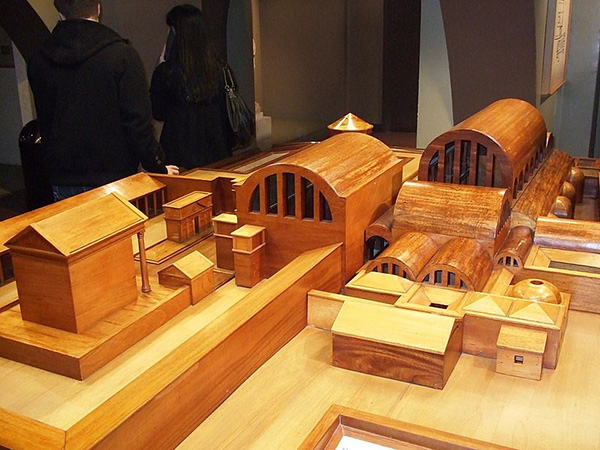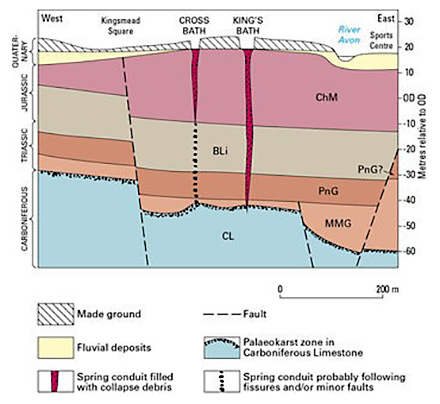![The Roman Baths (thermae) of Bath, England. Credit: Diliff (CC BY-SA 3.0 [http://creativecommons.org/licenses/by-sa/3.0/)]](/files/inline-images/ED137_001.jpg)
Geothermal energy comes in three varieties.
The first and most widespread is low-temperature heat—found everywhere, just below the surface—which can be used to maintain a constant temperature in buildings.
The second is much rarer: extreme heat found near volcanoes and fault zones, where high temperatures from deeper within Earth come close to the surface. These can produce steam to run electric power plants.
We’ll talk about both these types on future EarthDates.
The most commonly used geothermal energy, though, comes from hot springs—where rainwater seeps down into the Earth to reach deeper heat sources like magma chambers, then rises back out.
We’ve bathed in, and built around, them for thousands of years, often assigning them religious significance or health properties.
Romans constructed hundreds of baths at natural hot springs across Italy, often featuring elaborate architecture and plumbing systems, and they became an integral part of society—places to conduct business, politics, or courtship.
When the Romans conquered Europe, they expanded upon baths that earlier peoples had built in France, Hungary, Germany, and England.
Today, bathers still enjoy these and other hot springs. While more modern uses include heating houses, pasteurizing milk, and melting ice off streets.
Background
Synopsis: Geothermal energy is Earth’s natural heat. Over thousands of years, humans have learned to harness it for bathing, cooking, heating, and producing electricity. Direct geothermal energy, which comes from hot water emanating from springs or produced from wells, has driven human settlement and conquest for millennia.
- Geothermal energy comes from Earth’s natural heat.
- Geothermal derives from the Greek geo for “earth” and therme for “heat.”
- The deeper you go below Earth’s surface, the hotter it gets because of the pressure, the heat left over from Earth’s formation, and the constant decay of radioactive isotopes.
- Geothermal energy sources are concentrated along Earth’s plate boundaries, where Earth’s heat is enough to melt rocks to produce volcanoes and magma.

A wooden model of the Aquae Sulis complex as it would have looked in the 4th century AD. Credit: Rod Ward (public domain) - Geothermal energy occurs across a broad power spectrum.
- At the low end of the spectrum is ambient geothermal power, which comes from the natural constant temperature of rocks a few feet below the ground that may be accessed by household-scale geothermal heat pumps to provide heat in winter and remove heat in summer. (We’ll talk about this in a future EarthDate episode.)
- At the high end of the spectrum are geothermal power plants, which generate electricity at a regional scale as turbines are turned in reservoirs by geothermally heated fluids with temperatures up to 800oF (427oC). (We’ll also be discussing this in a future EarthDate episode.)
- Our focus here is direct geothermal energy, the type of geothermal energy with the longest human history; hot water issues directly from hot springs or is accessed by wells from geothermal reservoirs near Earth’s surface.
- For thousands of years, humans used direct geothermal energy from hot springs for bathing, preparing and cooking food, and piping through walls and floors to heat their homes.
- Greek baths have been found on the island of Crete at the palace complex at Knossos, which dates from before 1000 BC.
- A Chinese spa at Lisan Mountain dates to the Qin dynasty in the 3rd century BC. A palace was built around the site of the spa by later dynasties.
- Ancient Romans took full advantage of widespread hot springs in Italy created by volcanic activity.
- Bathing became an important social activity for the Romans—business deals were made and courtship was conducted in the baths.
- The Romans built communal baths called thermae at the locations of natural hot springs.
- The largest of these thermae covered several of Rome’s city blocks and could hold up to 3,000 bathers.
- A catalog of buildings in Rome in 354 AD included 952 baths.
- As their empire grew, the Romans constructed baths where they found hot springs elsewhere in Europe. Roman baths can be found in Aix and Vichy in France, Aachen and Wiesbaden in Germany, Bath and Buxton in England, Baden in Austria, and Aquincum in Hungary.
- During the 43 AD Roman conquest of England (then the Roman province of Britannia), the small town of Aquae Sulis in the valley of the River Avon was captured. This town in the southwestern English county of Somerset is now known as Bath.

- The first shrine on the site had been built by the Celts for their goddess Sulis. The Romans identified Sulis with Minerva, their goddess of wisdom and medicine.
- From 60 to 70 AD the Romans constructed a temple at the site; after about 300 years of additions, the large complex included the caldarium (hot bath), tepidarium (warm bath), and frigidarium (cold bath).
- Water pipes of lead carried and mixed the spring water.
- Admission fees for these baths in Roman times were very reasonable (and probably represent the first known commercial use of geothermal power).
- When the Romans left, early in the 5th century, the baths flooded and silted up. They were modified in the 12th and 16th centuries and restored more fully during the Victorian Era in the 1800s.
- The Roman Baths have been continuously conserved through the present. In 2011, they were fully restored at a cost of more than £5.5 million (about $8.5 million in 2011).
- Today, the baths in Bath are a major tourist attraction, receiving more than 1 million visitors a year.
- The Aquae Sulis spring issues more than 300,000 gal (1,170,000 L) of 115°F (46°C) water daily.
- Rainwater percolates through limestone aquifers to depths of as much as 14,000 ft (8900 m). There, geothermal sources heat the water and the hot, pressurized water travels back to the surface along fissures and faults.
- The thermal waters contain sodium, calcium, chloride and sulfate ions. Doctors in the 1600s prescribed drinking them, but today, drinking from and bathing in the Roman part of the springs is no longer advised because of the ancient lead plumbing.
- Recently, infectious diseases have been a concern after a girl contracted meningitis while swimming in the Baths in 1978 and died.
- Larger-scale and industrial use of direct geothermal energy has evolved through time.
- The oldest known district-scale geothermal heating system has been in operation since the 1300s in Chaudes-Aigues (“hot waters”), France.
- The first industrial use began in 1827 in Larderello, Italy, where boric acid was extracted from volcanic mud using steam from local geysers. The world’s first geothermal energy plant was built in Larderello in 1904.
- Starting around 1826, greenhouses were heated by hot-spring waters in Iceland, Tuscany, and Oregon.
- The first downhole heat exchanger was invented in 1930 in Oregon to directly convert heat from geothermal water into forced-air heating for buildings and entire towns.
- Iceland started heating homes with steam and hot water from geysers in 1943.
- Today, direct heat from geothermal waters is used in greenhouses and fish farms, as well as to dry crops and pasteurize milk. In Klamath Falls, Oregon, the city even melts snow and ice using geothermal water circulation under its roads and sidewalks.

